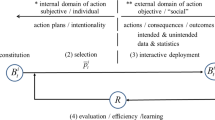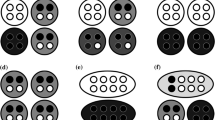Abstract
We try to construct an evolutionary theory of economic and social interaction of heterogeneous agents. Modern physics is helpful for such an attempt, as the recent flourishing of econophysics exemplifies. In this article, we are interested in a specific or more fundamental use of physics rather than in the recent researches of econo-physics. In the first part of this article, we mainly focus on the traditional von Neumann-Sraffa model of production as complex adaptive system and examine the measure of complexity on this model in view of thermodynamical ideas. We then suggest the idea of hierarchical inclusion on this model to define complexity of production. In the latter part, we try to construct an elementary theory of social interaction of heterogeneous agents in view of statistical mechanics.
Similar content being viewed by others
References
Anderson, P., K. Arrow and D. Pines (eds) (1988) The economy as an evolving complex system: studies in sciences of complexity, Addison-Wesley, Redwood CA.
Aruka, Y. (1996) “Dictatorship, the price-hike-like bubble and employment adjustment on the non-golden path of the von Neumann growth model with joint-production,” in Proceedings of the Econometric Society Australasian meeting (University of Western Australia, Perth) 1: 475–504.
- and J. Mimkes (2005) Complexity and interaction of productive subsystems under thermodynamical viewpoints, systems under thermodynamical viewpoints. (Presented at WEHIA2004: The 10th Workshop on Economics with Heterogeneous Interacting Agents, University of Essex, UK, June. 13–15, 2005.)
Bassett, G., R. Koenker and G. Kordas (2004) Pessimistic portofolio allocation and choquet expected utility, CEMMAP Working Paper CWP09/04.
Bellman, R. (1961) Adaptive control processes: a guided tour, Princeton University Press, Princeton, NJ.
Bierlaire, M. (1997) Discrete choice models, mimeo.
Frank, R. F. (1988) Passions within reasons. The strategic roll of the emotions, W. W. Norton, New York. (Paper edition (1989); German translation, Orednbourg (1992); Japanese translation, Saiensu-sha (1995); Greek translation, Kastoniosis (2000).)
Hodgson, G. M. (2003) “The preface to the Japanese version,” in Economics and evolution: bringing life back into economics (in Japanese), Toyokeizai Shimposha (translated in Japanese by T. Nishibe, M. Morioka and H. Tanaka). [Original edition, Polity Press, Cambridge (1993)]
Holland, J. H. (1992) Adaptation in natural and artificial systems. MIT Press, Cambridge, MA.
- (1995) Hidden order: how adaptation builds complexity, Perseus Books, Reading, MA.
Hoover, K. D. (2001) The Methodology of empirical macroeconomics, Cambridge University Press, Cambridge, UK.
Keynse, J. M. (1972) The end of laissez-faire, The collected writings of John Maynard Keynes, vol. IX, Essays in Persuasion, Macmillan, London.
Luce, R. (1959) Individual choice behavior: a theoretical analysis, Wiley and Sons, New York.
Mimkes, J. (2003) Thermodynamics of economic agent systems: Part III, University of Paderborn, Paderborn, mimeo.
Nash, J. F. (1951) “Noncooperative games,” Annals of Mathmatics 54: 286–295.
von Neumann, J. (1937) “Über ein Ökonomisches Gleichungssystem und eine Verallgemeinung des Brouwerschen Fixpunktsatzes,” in K. Menger (ed) Ergebnisse eines Mathematischen Kolloquiums 8: 73–83 (translated in English (1945) “A model of general economic equilibirum,” Review of Economic Studies 13: 1–9).
Schefold, B. (1989) Mr. Sraffa on joint production and other essays, Unwin Hyman, London.
Sraffa, P. (1960) Production of commodities by means of commodities, Cambridge University Press, Cambridge UK.
Strang, G. (1991) Calculus, Cambridge Press, Wellesley, MA.
Weidlich, W. (2000) Sociodynamics: a systematic approach to mathematical modelling in the social sciences, Harwood Academic Publisher, London. [Reprinted by Taylor and Francis (2002); Paper edition, Dover Publication (2006); Japanese translation, Morikita Shuppan (2006) in press]
Author information
Authors and Affiliations
Corresponding author
About this article
Cite this article
Aruka, Y., Mimkes, J. An Evolutionary Theory of Economic Interaction—Introduction to Socio- and Econo-Physics. Evolut Inst Econ Rev 2, 145–160 (2006). https://doi.org/10.14441/eier.2.145
Published:
Issue Date:
DOI: https://doi.org/10.14441/eier.2.145
Keywords
- heterogeneous interaction
- complex adaptive system
- thermodynamics
- complexity of production
- truncation of a production system
- hierarchical inclusion
- social temperature




